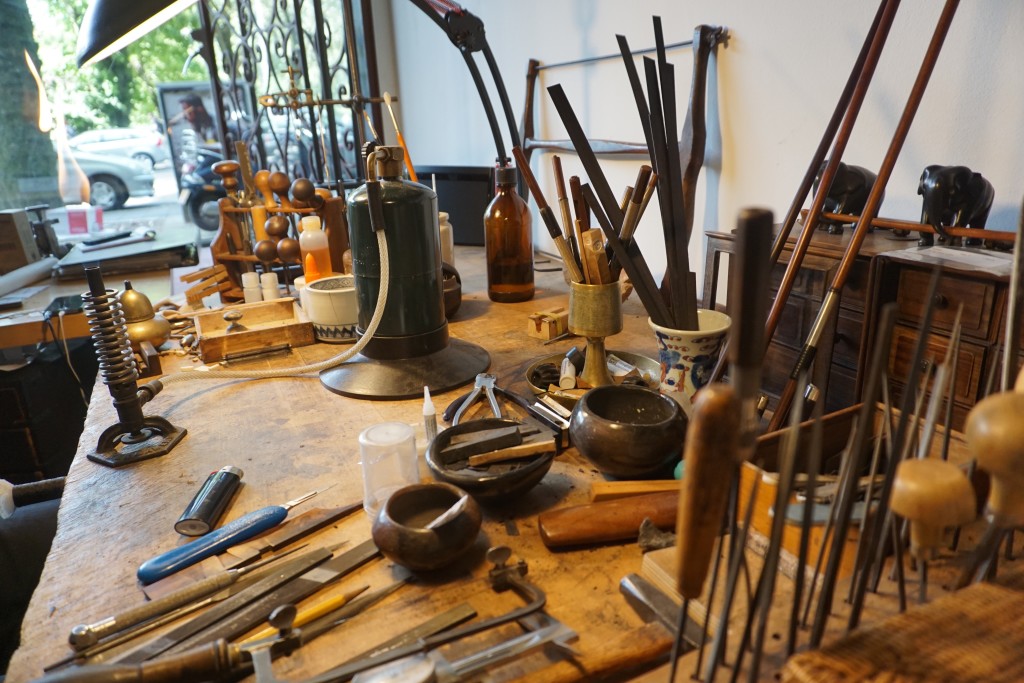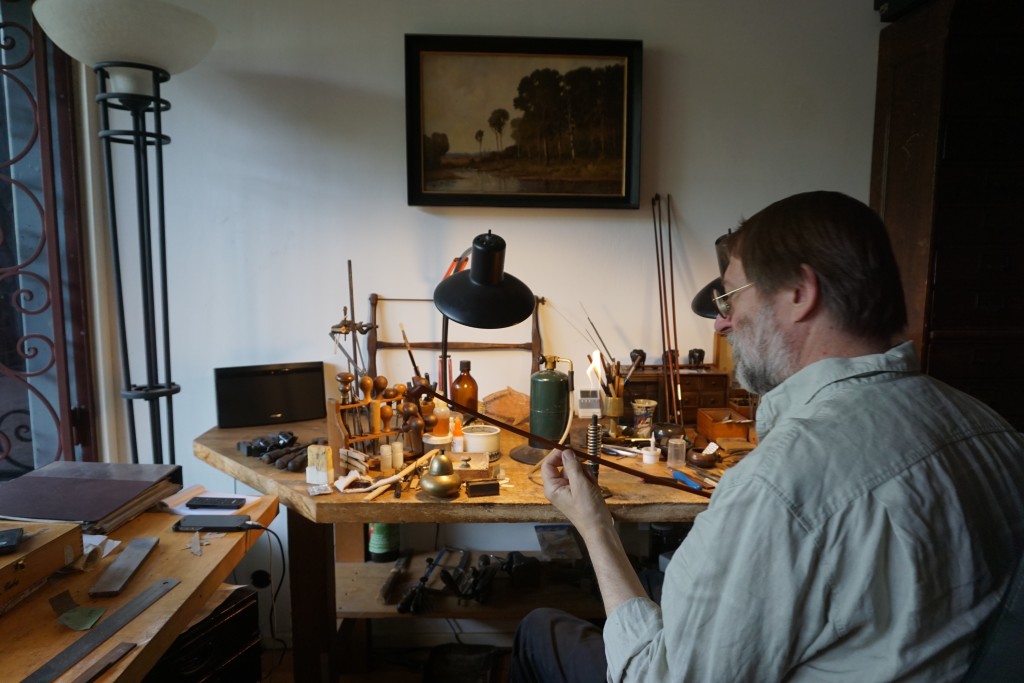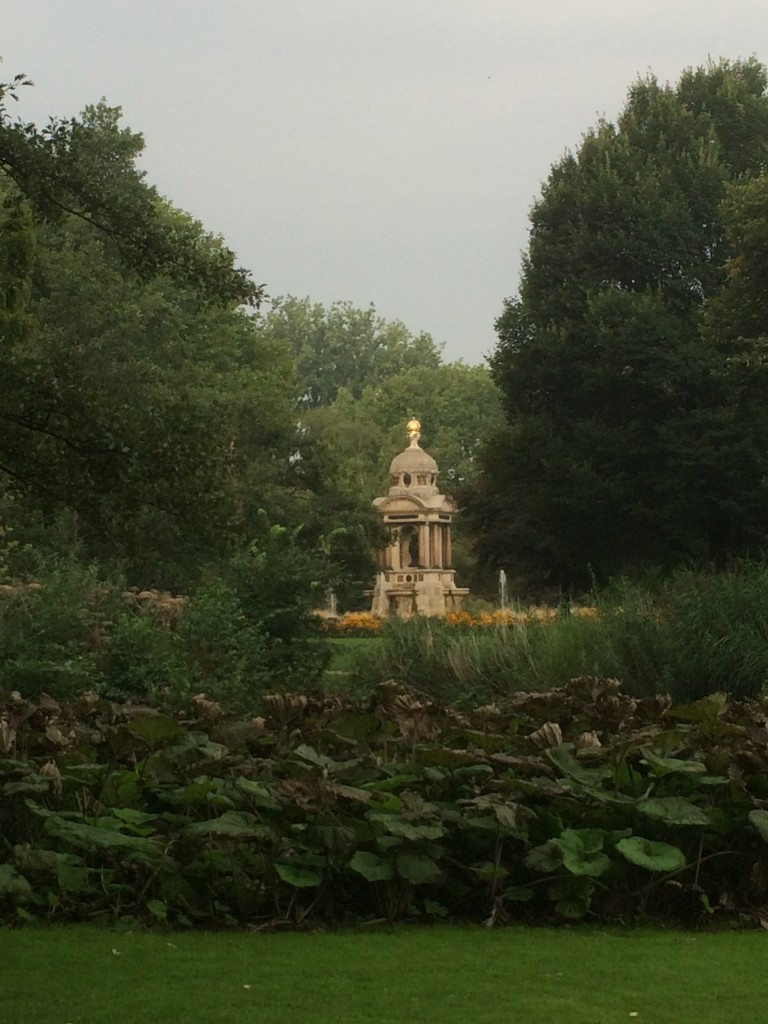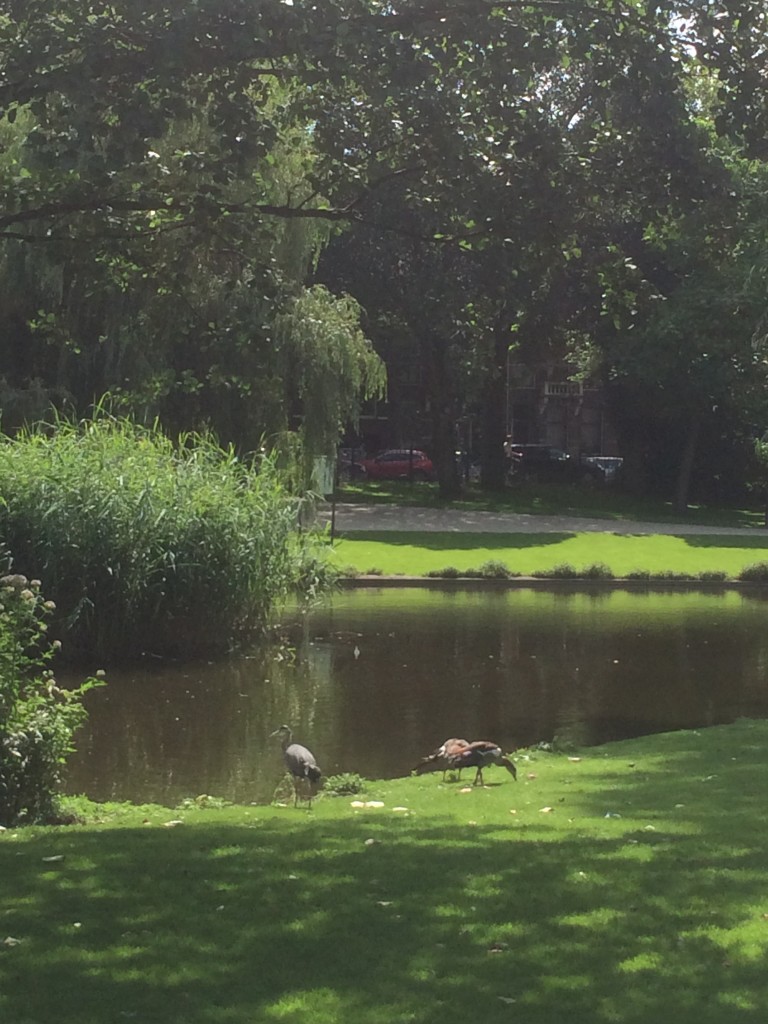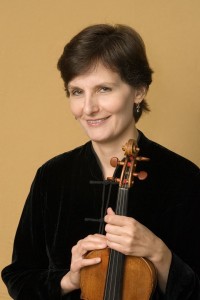I received news yesterday of a seriously talented group of musicians who are spontaneously celebrating my work with a concert in NYC during our trip there on Oct 1-8. I am deeply humbled and grateful for their generosity. This is an amazing honor for any bow maker and for it to spotlight what I have tried to accomplish for all these years is a bit overwhelming. My deepest and most sincere thanks to the many gifted musicians who have supported me through the years, and specifically to these amazing musicians.

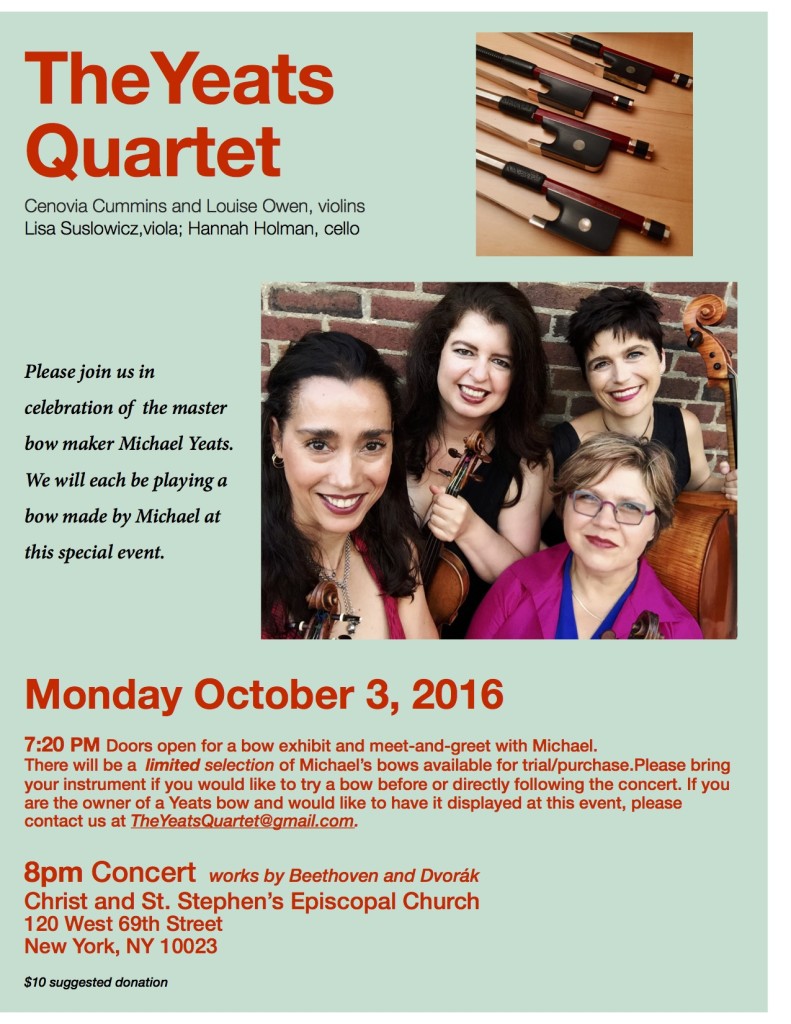
 These 3 new violin bows, when finished, will be making the trip to NYC and will arrive shortly before our arrival on Oct 1st. The top bow is a big bow, in the Pajeot school, and is octagonal. The middle bow is my usual Yeats head, and should be outstanding, and the closest of the three to play like work from the 19th century. The bow on the bottom will be very much like the great early dark-red bows from Sartory. Something for all tastes. I look forward to seeing everyone I can while in New York. I will not have a work space available for this trip, but I will be more than happy to meet with anyone who may have an interest in my work.
These 3 new violin bows, when finished, will be making the trip to NYC and will arrive shortly before our arrival on Oct 1st. The top bow is a big bow, in the Pajeot school, and is octagonal. The middle bow is my usual Yeats head, and should be outstanding, and the closest of the three to play like work from the 19th century. The bow on the bottom will be very much like the great early dark-red bows from Sartory. Something for all tastes. I look forward to seeing everyone I can while in New York. I will not have a work space available for this trip, but I will be more than happy to meet with anyone who may have an interest in my work.
Yeats Quartet Concert – Oct 3, NYC
Move to Amsterdam
Our move to Amsterdam was completed last month. I am very pleased to announce that I have set up shop in the Muziek Gallery Matelski, Sarphatipark 74, across from beautiful Sarphatipark in Amsterdam.
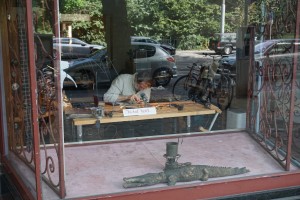
I am enjoying a collaboration with Moti Matelski, who has had a presence in De Pijp for about 30 years. My shop space is in the front of his ground floor studio, so I am still getting used to being a street presence and the subject of dozens of tourist videos.
One of the many benefits of living in Amsterdam is the 10 minute walk to the shop through Sarphati Park. Located just south of the center of Amsterdam, the park is named after Samuel Sarphati, a doctor of Portuguese-Jewish origin, who played an important role in developing aspects of 19th century Amsterdam. The beautiful fountain in the middle of the park is dedicated to his memory.
The park is home to many ducks, Egyptian geese, and a pair of fearless gray heron. The shop is located directly behind the red car.
Interview with Erica Kiesewetter of the American Symphony Orchestra
I was lucky enough to catch violinist Erica Kiesewetter despite her very busy schedule (seriously, check out her bio at the end!) to ask her a few questions. Associate professor, coach, and busy performer, she is an accomplished musician and wonderful role model for the young artists she guides.
Her next performance will be a program of chamber music by Enrique Granados on April 14 in New York, NY. For more information click here. She will also be performing with the Stamford Piano Trio on July 14 in Katonah, NY. For more information click here.
Also be sure to check out her recording of the Berg Violin Concerto with the American Symphony Orchestra on iTunes here.
-Alicia Castaneda
On her influences:
AC: What book has most influenced your playing?
EK: Konstantin Stanislavsky’s The Actor Prepares. I read this book when I was a teenager, and it completely opened me up to the idea of channeling emotions known to us into our music-making.
AC: What purchase in the last year has most influenced your playing?
EK: I recently bought a bow by the American bow maker Michael Yeats. I have been devoted to my Voirin for a quarter of a century, but was pleasantly surprised to discover new possibilities with this marvelous stick!
AC: What players did you look up to when you were a student?
EK: I was lucky enough to be in the Colorado Quartet as a Juilliard student, and we were blessed to be coached intensively by the Juilliard String Quartet. Robert Mann was a never-ending inspiration to me, as I realized through him that it is the concept in your mind which shapes your playing, and with a strong enough image you can find a way to make a phrase work.
AC: Who do you look up to outside of the music industry?
EK: I look up to and learn from my two wonderful children, who are both blessed with boundless curiosity and determination.
“…it is the concept in your mind which shapes your playing, and with a strong enough image you can find a way to make a phrase work.”
On performance:
AC: Do you get stage fright? How do you cope?
EK: Having played now for half a century I don’t get stage fright per se. But I always feel some adrenaline rushes and I welcome them–they tell me I am alive and excited! Over the years I have developed many techniques for dealing with stage fright, which I now teach to others. Basically they all have to do with mind control, both learning to center oneself and be able to access quickly a relaxed state, but also visualization techniques throughout the whole preparation/practice period.
AC: What recording/concert are you most proud of?
EK: I have been lucky enough to have made innumerable recordings with Orpheus, with my own piano trio, many chamber groups, and hundreds of live recordings with the American Symphony, of unusual repertoire. But if I had to pick one it would be of the Berg Concerto (available on itunes!) with Leon Botstein and the American Symphony Orchestra. This piece speaks to me like no other, and having performed the piece both in the US and Israel with Maestro Botstein, I felt we were able to have a real freedom.
On instruments:
AC: What do you think is the most important thing for a player to keep in mind when they are shopping for an instrument?EK: There are many things to keep in mind, such as resale value, condition, comfort, etc., but the key thing is that the instrument must speak to you. I will never forget bringing my Carlo Antonio Testore back to my apartment in NYC for the first time. I picked it up at the Met Opera from a colleague after a performance. Since I could not play the violin late at night I had to content myself with plucking it only; I fell in love with it that way!
On her past:
AC: If you could do anything differently on your career path, what would you change?
EK: I wish I had allowed myself the time to get a real education also. There is so much more in the world than just sitting in the practice room, or worrying that you are not practicing enough.
AC: What advice would you give your 16-year-old self?
EK: Don’t compare yourself to others. Just stick to your joy of music-making and trust you will improve!
On the future:
“As long as people can hear and can feel emotions there will be classical music to be shared.”
AC: How do you envision your role in the future of classical music?
EK: I have been blessed with a multi-faceted career (chamber music in my twenties and early thirties, then concertmaster of many orchestras). Now, although I still have an active playing career, I am teaching much more, from violinists who may not become professionals to grad students. One of the things I have come to cherish is just how much someone’s life can be enriched by classical music even if they will not make a career of it. As long as people can hear and can feel emotions there will be classical music to be shared.
On the world outside of classical music:
AC: Your career is playing classical music. What other types of music do you enjoy playing or listening to?
EK: I love jazz! I love the challenge of using my ears to try to comprehend something I really don’t understand.
AC: If you could have gone into another profession, what would it be?
EK: There was never any other possibility for me. But now that I have had such a rich and full and enjoyable life of music-making I sometimes think I would like to give back to the world in some more tangible way. But, since my only skill sets revolve around music I will content myself with teaching, and hope I am making a small difference in the world.
Violinist Erica Kiesewetter is a Visiting Associate Professor at Bard College where she maintains a violin studio in the music department as the Director of Orchestral Studies at the Bard Conservatory and most recently as the string audition and sectional coach for the new graduate program The Orchestra Now (TON). She has also been on the faculty of Columbia University, and coached orchestra classes at Juilliard, Mannes, Manhattan School, SUNY Purchase, and the School for Strings. She is on the faculty of the Round Top Institute in the summers, and also specializes in giving workshops for overcoming performance anxiety. Ms. Kiesewetter was a student of the great violin pedagogue Ivan Galamian at the Juilliard School, and has also studied with Joyce Robbins, Gerry Beal, Emanuel Vardi, and Charles Castleman.
Ms. Kiesewetter has been the concertmaster of the American Symphony Orchestra since 2001 and is also the concertmaster of the Stamford Symphony, Northeastern PA Philharmonic, and the Opera Orchestra of N.Y. She has appeared frequently as a concerto soloist with these groups, and her performance of the Berg Violin Concerto with Leon Botstein and the American Symphony Orchestra is available now on iTunes. Her solo appearance on a recording of the music of Granados was nominated for a Grammy. She has also been the concertmaster of the New York Pops, Amici New York, the Long Island Philharmonic, and Eos, and has toured and recorded extensively with the Orpheus Chamber Orchestra. Her summers are divided between the Bard Music Festival, OK Mozart, and Round Top. An avid chamber musician, Ms. Kiesewetter is the former first violinist of the Colorado and Dakota Quartets, and a member of the Leonardo Trio for 14 years. She received prizes as members of these groups at the Coleman, Evian, and Concert Artist Guild competitions, and performed concerts with these and other groups in 49 U.S. States, Canada, and many European and South American countries. She is currently a member of the Bardian Ensemble.
Tip Clinic and New Bows in NYC
We’re happy to announce a long-overdue trip to NYC this coming May! The Yeats road show will be in the Apple in mid-May to show a few new Yeats violin bows and to address the current tip issue with clients’ bows. I’m certain everyone is aware of how difficult authorities are making it to travel with any sort of ivory tips on bows. With the increased scrutiny of instruments and recent, more rigorous enforcement of the elephant ivory ban, many musicians are ready to make the switch to a non-ivory alternative. I will be offering a tip replacement service for bows with my two preferred replacement materials, silver or ebony. I have not found a suitable, artificial ivory replacement material and prefer not to use any material that could be mistaken for elephant ivory by customs officials. My silver tips are glued, not pinned, to prevent any future cracking issues that may result from the use of pins. The ebony is a very dense and strong version that I have available and have used recently on a few Francois Peccatte shop bows with great success.
 Although the ebony is a bit more fragile than mammoth, it is gorgeous material, and the finished head is reminiscent of early Dodd bow heads. The choice of tip material depends upon the weight and balance of your bow and your style of playing. An ebony tip will be a lighter weight. A silver tip will be the same weight or heavier.
Although the ebony is a bit more fragile than mammoth, it is gorgeous material, and the finished head is reminiscent of early Dodd bow heads. The choice of tip material depends upon the weight and balance of your bow and your style of playing. An ebony tip will be a lighter weight. A silver tip will be the same weight or heavier.
Those interested in seeing my new bows or having tip work done, kindly e-mail for available dates to schedule a bow trial or reserve a space in the tip-clinic schedule. The cost of replacing a tip will be $125 for ebony, $195 for silver.
We look forward to seeing everyone in May.
P. Simon Violin Bow Copy
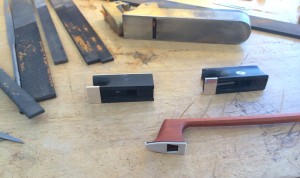 A few weeks before our scheduled move to the Netherlands, I received an e-mail from Lisa Fako, a friend and former client in New York who is now living in the Chicago area. She owns a great P. Simon bow that shows evidence of having been part of a famous private collection in New York. The bow had a previous head graft, which had failed. Lisa wanted to know whether it could be restored a second time. Multiple repairs are possible, but a bow can be less dependable as a primary tool the more work is done to it.
A few weeks before our scheduled move to the Netherlands, I received an e-mail from Lisa Fako, a friend and former client in New York who is now living in the Chicago area. She owns a great P. Simon bow that shows evidence of having been part of a famous private collection in New York. The bow had a previous head graft, which had failed. Lisa wanted to know whether it could be restored a second time. Multiple repairs are possible, but a bow can be less dependable as a primary tool the more work is done to it.
After some discussion, we ultimately decided that the best option was for me to both search my collection of pernambuco wood for a comparable stick and to make a new violin bow to match the original bow as closely as possible, and then restore the original with another head graft.
 The new bow blank was chosen, roughed in, and the head defined, though the process of determining what the original head might have looked like was a challenge. The bow maker who had done the previous head graft made the new head to look much like the work of Dominique Peccatte. The bow may very well have masqueraded as a Peccatte for decades, as the quality of the stick is that good. But a Simon it is, so I created the head of the new bow to look more like a Simon.
The new bow blank was chosen, roughed in, and the head defined, though the process of determining what the original head might have looked like was a challenge. The bow maker who had done the previous head graft made the new head to look much like the work of Dominique Peccatte. The bow may very well have masqueraded as a Peccatte for decades, as the quality of the stick is that good. But a Simon it is, so I created the head of the new bow to look more like a Simon.
We’ll work out in the future whether the original Simon will have a new head which resembles the failed graft, or one like Simon’s more typical work. It is not often that I am able to work this closely with a client on a bow project. It was a pleasure working with Lisa to create her new bow.
